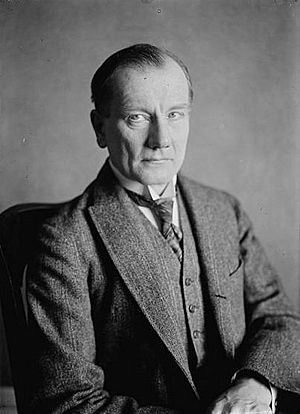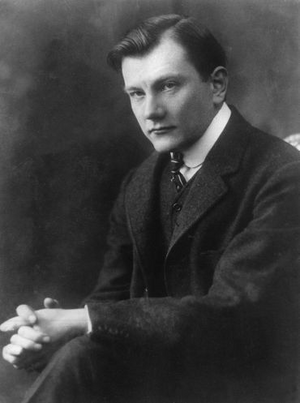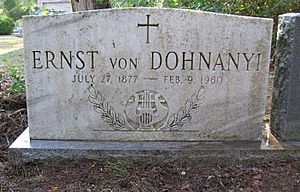Ernst von Dohnányi facts for kids
Ernst von Dohnányi (Hungarian: Dohnányi Ernő; 27 July 1877 – 9 February 1960) was a famous Hungarian composer, pianist, and conductor. He used a German version of his name for most of his published music.
Contents
Biography
Early Life and Musical Start
Dohnányi was born in Pozsony, which was then part of the Kingdom of Hungary and is now Bratislava, the capital of Slovakia. His first music teacher was his father, Frigyes Dohnányi, who was a math professor and played the cello as a hobby. When Ernst was eight, he also studied with Carl Forstner, an organist at the local church.
In 1894, at age 17, he moved to Budapest. He joined the Royal National Hungarian Academy of Music. There, he learned piano from István Thomán, who was a favorite student of Franz Liszt. He also studied composition with Hans von Koessler.
Musical Influences and Early Success
Franz Liszt's style greatly influenced Dohnányi's piano playing. Hans von Koessler, on the other hand, loved the music of Johannes Brahms. Brahms's music had a big impact on Dohnányi's compositions. In fact, Brahms himself liked Dohnányi's first published work, the Piano Quintet in C minor, and helped promote it in Vienna.
Dohnányi finished his studies at the Academy quickly. In June 1897, he took his final exams early and passed with very high marks. He graduated as both a composer and a pianist before he was 20 years old.
After a few lessons with Eugen d'Albert, another student of Liszt, Dohnányi made his first public appearance in Berlin in 1897. He was immediately recognized as a very talented performer. He had similar success in Vienna and during a tour across Europe. He also performed in London, playing Beethoven's Piano Concerto No. 4. He was one of the first conductors to help make Bartók's music popular.
In 1898, Dohnányi visited the United States. He became known for playing Beethoven's Piano Concerto No. 4 with the St. Louis Symphony Orchestra. Unlike many famous pianists of his time, he didn't just play solo concerts. He also performed chamber music, which involves a small group of instruments. In 1901, he finished his Symphony No. 1, his first major work for an orchestra.
Family Life and Teaching Career
Dohnányi married Elisabeth "Elsa" Kunwald, who was also a pianist. They had a son named Hans in 1902. Hans later became a leader in the anti-Nazi resistance in Germany and was sadly executed during World War II. Hans was the father of the German politician Klaus von Dohnanyi and the conductor Christoph von Dohnányi. Ernst and Elsa also had a daughter, Greta.
From 1905 to 1915, Dohnányi taught at the Hochschule in Berlin. He was invited by the famous violinist Joseph Joachim, a close friend of Brahms. During this time, Dohnányi wrote The Veil of Pierrette and the Suite in F-sharp minor.
After returning to Budapest, he performed many concerts. In 1919, he became the Director of the Budapest Academy. Later, he was named Music Director of the Budapest Philharmonic Orchestra. In this role, he helped promote the music of other Hungarian composers like Béla Bartók and Zoltán Kodály. He also became a very respected teacher. Many of his students became famous musicians, including Géza Anda, Annie Fischer, and Sir Georg Solti. In 1933, he started the first International Franz Liszt Piano Competition.
Fighting Against Nazi Influence
In 1934, Dohnányi was again appointed Director of the Budapest Academy of Music. He held this position until 1943. From 1939, he spent much of his time fighting against the growing influence of the Nazis.
By 1941, he resigned from his director job at the Academy. He did this rather than follow anti-Jewish laws that would have forced him to fire Jewish teachers. In his orchestra, the Budapest Philharmonic, he managed to keep all Jewish members until March 1944. At that point, after Germany occupied Hungary, he disbanded the orchestra completely.
Historians like James A. Grymes have researched Dohnányi's actions during the Holocaust. Grymes calls him "a forgotten hero of the Holocaust resistance." Dohnányi did many brave things:
- He stopped the creation of a Hungarian Chamber of Music that would have kept Jewish musicians out of the profession.
- He resigned from his job rather than fire Jewish teachers.
- He disbanded his orchestra instead of dismissing its Jewish members.
- He personally helped many Jewish musicians. For example, he helped impresario Andrew Schulhof move to the United States. He also helped pianist Lajos Hernádi avoid forced labor by saying his hands were "irreplaceable national treasures." He helped violinist Carl Flesch and his wife escape to Switzerland. He even saved pianist György Ferenczy and his family from death trains.
After the war, the U.S. Military Government investigated Dohnányi several times and cleared him of any wrongdoing. Many prominent Jewish musicians who worked with him in Hungary, like Edward Kilenyi and Leó Weiner, defended him. They pointed out that most of his students were Jewish and that he continued to perform Jewish composers' music even during the Nazi regime.
Later Life in the United States
In 1949, Dohnányi began teaching at the Florida State University School of Music in Tallahassee. He taught there for ten years. He and his wife, Ilona Zachár, became American citizens in 1955.
In the United States, he continued to compose music. He became interested in American folk music. His last orchestral work, American Rhapsody (1953), included folk songs like "Turkey in the Straw" and "On Top of Old Smoky".
His very last public performance was on January 30, 1960, at Florida State University. He conducted the university orchestra playing Beethoven's Piano Concerto No. 4.
Death
Dohnányi passed away from pneumonia on February 9, 1960, in New York City. This was just ten days after his final performance. He was buried in Tallahassee, Florida, where he had taught for a decade.
Influence and Legacy
- The BBC released a recording from one of his last concerts in 1959, where he played Beethoven and Schubert piano sonatas.
- His three volumes of Daily Finger Exercises for the Advanced Pianist were published in 1962 and are still used by piano students.
- The Warren D. Allen Music Library at Florida State University has a large collection of Dohnányi's papers and music.
- In 1990, the Hungarian government honored him with its highest civilian award, the Kossuth Prize.
- An International Ernst von Dohnányi Festival was held at Florida State University in 2002 to celebrate his life and music.
Compositions
Dohnányi's music style was unique but also quite traditional. His music mostly fits into the Romantic period. While he used some elements of Hungarian folk music, he didn't use them in the same way as composers like Bartók or Kodály. Some people describe his style as similar to Brahms, but others hear very little of Brahms in his music.
Some of his most famous works include his Serenade in C major for string trio, Op. 10 (1902), and Variations on a Nursery Tune for piano and orchestra, Op. 25 (1914). His Second Symphony is a major work he wrote during World War II. It is quite serious, especially in its third movement.
Stage Works (Operas and Ballets)
- Der Schleier der Pierrette (The Veil of Pierrette), Op. 18 (1909)
- Tante Simona (Aunt Simona), Comic Opera, Op. 20 (1912)
- A vajda tornya (The Tower of the Voivod), Romantic Opera, Op. 30 (1922)
- A tenor (The Tenor), Comic Opera, Op. 34 (1927)
Choral Works (for Choir)
- Szegedi mise (Szeged Mass), Op. 35 (1930)
- Cantus vitae, Symphonic Cantata, Op. 38 (1941)
- Stabat mater, Op. 46 (1953)
Orchestral Works
- Symphony No. 1 in D minor, Op. 9 (1901)
- Suite in F-sharp minor, Op. 19 (1909)
- Ünnepi nyitány (Festival Overture), Op. 31 (1923)
- Ruralia hungarica (based on Hungarian folk tunes), Op. 32b (1924)
- Symphony No. 2 in E major, Op. 40 (1945, revised 1954-7)
- American Rhapsody, Op. 47 (1953)
Works for Solo Instrument and Orchestra
- Piano Concerto No. 1 in E minor, Op. 5 (1898)
- Konzertstück (Concertpiece) in D major for cello and orchestra, Op. 12 (1904)
- Variations on a Nursery Tune for piano and orchestra, Op. 25 (1914)
- Violin Concerto No. 1 in D minor, Op. 27 (1915)
- Piano Concerto No. 2 in B minor, Op. 42 (1947)
- Violin Concerto No. 2 in C minor, Op. 43 (1950)
Chamber and Instrumental Music
- Piano Quintet No. 1 in C minor, Op. 1 (1895)
- String Quartet No. 1 in A major, Op. 7 (1899)
- Sonata in B♭ minor for cello and piano, Op. 8 (1899)
- Serenade in C major for string trio, Op. 10 (1902)
- String Quartet No. 2 in D♭ major, Op. 15 (1906)
- Sonata in C♯ minor for violin and piano, Op. 21 (1912)
- Piano Quintet No. 2 in E♭ minor, Op. 26 (1914)
- String Quartet No. 3 in A minor, Op. 33 (1926)
- Sextet in C major for piano, strings and winds, Op. 37 (1935)
Piano Music
- Four Pieces, Op. 2 (1897)
- Passacaglia in E♭ minor, Op. 6 (1899)
- Four Rhapsodies, Op. 11 (1903)
- Winterreigen, Op. 13 (1905)
- Humoresque in the form of a Suite, Op. 17 (1907)
- Six Concert Etudes, Op. 28 (1916)
- Variations on a Hungarian Folksong, Op. 29 (1917)
- Ruralia hungarica, Op. 32a (1923)
- Six Pieces, Op. 41 (1945)
- Twelve Short Studies for the Advanced Pianist (1951)
See also
 In Spanish: Ernő Dohnányi para niños
In Spanish: Ernő Dohnányi para niños




